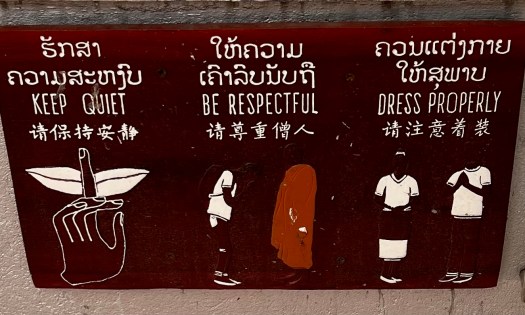
https://en.wikipedia.org/wiki/Kuang_Si_Falls

















https://en.wikipedia.org/wiki/Kuang_Si_Falls

















Kalasin, Thailand













Luang Prabang




















To “disrobe” is the process for a monk to leave monastic/temple life. In Laos a friend who was until recently a monk left temple life at the age of 25 after 10 years as a novice and 4 years as a monk. In some blog I will comment on why young men in Laos and Thailand become monks but this blog will focus on the “disrobing”.
I must explain there is a difference between the two ranks of those in temple life. Firstly someone joins the temple as a novice from the age of 12 onward. At the age of 20 or 21 a novice can be “ordained” as a MONK if he so chooses.
You might think it is a simple thing to just “leave” the temple and join the rest of society but in Laos the process is somewhat complicated.

First the monk must make up his own mind to “disrobe”. Normally he then consults with the family and discusses his decision. It could be the family persuades him to continue as a monk but in the end it is the monk’s decision to leave temple live.
Once the monk has made the final decision he will go to the Abbot of the temple and ask when the best day is for him to “disrobe”. Once the date is set the monk will fill out the document declaring his decision to “disrobe” and it will be “stamped” by the Abbot and the head of the temple district. This document is very important as I will explain.

In Laos everyone is required to get an ID card. Monks can have a national ID card with a photo of them in robes or an ID issued by the temple. These documents are used to apply for a Passport which identifies the person as a monk. When the monk disrobes the document stamped by the Abbot and temple office is required to apply for a “layman” (regular citizen) ID card and passport. Once that ID card is issued the ID card and the family book indicating the name and address of the people in the family are used to apply for a passport. The monk is registered in the temple “family book”. Once he leaves the temple he needs to be re-registered with the family in the family book as the next step.
The application for the passport needs to be filled out with a photo of the applicant as well as a color copy of the ID card. That application form is then stamped by the village head to verify the details of the application form. The person then goes to the “Consular Office” to line up to get an appointment for an interview which only confirms the details in the application.
If the monk opens a bank account the name on the account has “monk” printed after the family name and is the account name. When the monk disrobes he needs to change the name on his bank accounts to delete “monk” in the name on the account. The disrobing document is necessary to make this change.
In short a monk is identified throughout society as a monk and receives sometimes special treatment while they are restricted by their rules and regulations regarding their monk-hood and vows. In Laos and Thailand, if a monk is not in their required monk’s robes (required at all times) and stopped by police, the police will normally ask to see the ID card. Seeing the ID card identifying the person as a “monk” the police will turn the person over to the temple for discipline which often results in banishment from temple life. So there is a strong relationship between the monk’s social requirements and the documents they have identifying them.
In Laos, as in Thailand, the prefixes before the names are often used in spoken language. “Tao” is generally used for men younger than 40 or so. If a man is named SOMPONE, he is addressed as “Tao Sompone”. If Sompone disrobes as a novice he is addressed as Xieng Sompone while a monk who disrobes is addressed as “Tid Sompone”. This change in prefix will go on for a certain period of time by those who know him as a former monk.
By the way, you can recognize a monk who has recently disrobed; short hair and shaved eyebrows.
Here ends the blog on a monk “disrobing”.